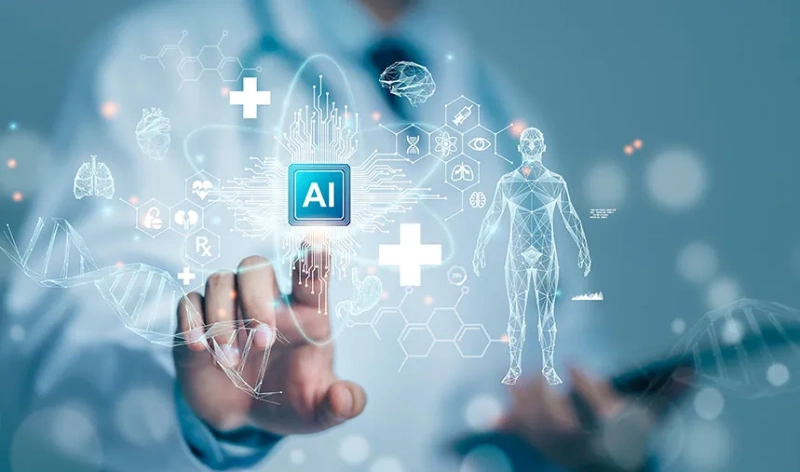I. Introduction: The New Era of Healthcare Intelligence
AI is no longer future speculation—it’s actively diagnosing diseases and personalizing treatments today. Across the globe, hospitals and research institutions are witnessing remarkable transformations: algorithms that can detect cancers from medical images with accuracy rivaling human experts, systems that can predict patient deterioration hours before clinical symptoms appear, and tools that are slashing drug development timelines from years to months. This isn’t science fiction; this is the current state of healthcare AI.
The healthcare AI revolution is creating better patient outcomes while generating unprecedented computational demands. Every breakthrough in medical AI comes with a hidden requirement: massive computing power to process enormous datasets, train complex models, and deliver real-time insights. The sophisticated algorithms that promise to revolutionize patient care require infrastructure that can handle their complexity and scale.
In this article, we’ll explore cutting-edge applications transforming patient care and examine the robust infrastructure needed to power them responsibly. Because in healthcare, where lives are on the line, reliable computational power isn’t just a technical requirement—it’s a medical necessity.
II. Real-World AI Applications Revolutionizing Healthcare
The theoretical potential of AI in healthcare has become practical reality across multiple domains. These applications are already making a measurable difference in patient care and medical research:
Medical Imaging Analysis: AI-assisted radiology and pathology
AI systems are now routinely analyzing X-rays, CT scans, and MRIs, helping radiologists detect abnormalities faster and with greater accuracy. In pathology, AI algorithms can examine tissue samples for cancerous cells, processing thousands of images in the time a human pathologist might review dozens. These systems aren’t replacing doctors but augmenting their capabilities, serving as incredibly thorough second opinions that never experience fatigue.
Drug Discovery Acceleration: From target identification to clinical trials
Pharmaceutical companies are using AI to dramatically shorten drug development cycles. Machine learning models can analyze biological data to identify promising drug candidates, predict how molecules will interact with targets in the body, and even design new compounds with specific therapeutic properties. This acceleration is particularly crucial in responding to emerging health threats, where traditional drug development timelines are unacceptably long.
Personalized Treatment Plans: Genomics and patient data integration
By analyzing a patient’s genetic information alongside their medical history and current health status, AI systems can help doctors develop truly personalized treatment plans. These systems can predict how individuals will respond to different medications, identify their risk factors for various conditions, and recommend preventative measures tailored to their specific biology.
Operational Efficiency: Hospital workflow optimization and administrative automation
Beyond clinical applications, AI is transforming healthcare operations. Intelligent systems are optimizing staff schedules, predicting patient admission rates to better manage resources, and automating administrative tasks like billing and documentation. This allows healthcare providers to focus more resources on patient care while reducing operational costs.
III. The Computational Challenge Behind Healthcare AI
Beneath these revolutionary applications lies a formidable computational challenge that many healthcare organizations underestimate until they begin their AI journey:
Massive data requirements: Medical images, genomic sequences, and patient records
Healthcare datasets are among the largest and most complex in any industry. A single hospital can generate terabytes of data daily from medical imaging alone. Genomic sequencing produces enormous files for each patient, while electronic health records accumulate decades of detailed patient history. Training AI models on these datasets requires not just substantial storage but immense processing power to extract meaningful patterns.
Need for rapid processing: Time-sensitive diagnostics and research timelines
In many healthcare scenarios, speed matters critically. An AI system that takes hours to analyze a stroke patient’s brain scan provides little clinical value. Similarly, drug discovery research moves competitively, where faster computation can literally translate to lives saved. These time-sensitive applications demand high-performance computing infrastructure that can deliver results when they’re needed.
Regulatory compliance: Secure, reliable, and auditable computing environments
Healthcare AI operates under strict regulatory frameworks like HIPAA that mandate rigorous data protection, system reliability, and complete auditability. Computational infrastructure must ensure data security without compromising performance, maintain detailed access logs, and provide the stability required for clinical applications where downtime isn’t just inconvenient—it could impact patient care.
These challenges create a difficult balancing act for healthcare organizations: they need cutting-edge computational power, but they also require the security, reliability, and compliance features that general-purpose cloud solutions often struggle to provide.
IV. WhaleFlux: Powering Healthcare AI with Reliable GPU Infrastructure
This is where WhaleFlux serves as a critical enabler for healthcare AI initiatives. WhaleFlux provides the computational backbone that healthcare organizations need to deploy AI applications confidently and effectively, balancing performance with the unique requirements of the medical field.
WhaleFlux is an intelligent GPU resource management tool designed specifically for demanding AI applications, and it offers several key benefits for healthcare organizations:
Guaranteed availability for critical research and diagnostics
Unlike general-purpose cloud platforms where resources might be reclaimed or performance might vary, WhaleFlux provides dedicated access to computational resources. This guaranteed availability is crucial for healthcare applications where interrupted training jobs could delay research breakthroughs, and inconsistent inference performance could impact diagnostic accuracy.
Secure, compliant infrastructure for sensitive health data
WhaleFlux is built with the security requirements of healthcare data in mind. The platform provides the isolation, encryption, and access controls needed to handle protected health information while maintaining the performance necessary for complex AI workloads. This allows healthcare organizations to leverage their data for AI innovation without compromising on security or compliance.
Cost-effective scaling for research projects and production systems
Through intelligent resource optimization across multi-GPU clusters, WhaleFlux helps healthcare organizations maximize their computational investment. The platform’s efficient scheduling and load balancing ensure that expensive GPU resources are fully utilized, whether for research experiments or production diagnostic systems.
The WhaleFlux platform supports a range of NVIDIA GPUs tailored to different healthcare workloads. The flagship NVIDIA H100 and H200 cards provide the raw power needed for massive drug discovery simulations and foundation model training. The reliable A100 serves as an excellent balance of performance and stability for production medical imaging systems. For research and development work, the RTX 4090 offers tremendous value for prototyping new algorithms and processing smaller datasets.
V. Healthcare AI Success Stories: From Research to Reality
The transformative potential of healthcare AI becomes most evident when examining real-world implementations:
Case study 1: Medical research institution accelerating drug discovery
A prominent medical research foundation was struggling with computational limitations in their Alzheimer’s disease research. Their molecular simulation experiments were taking weeks to complete, dramatically slowing their search for promising therapeutic compounds. After implementing WhaleFlux with NVIDIA H100 GPUs, they achieved a 7x speedup in their simulation workflows. What previously took 21 days now completes in just 3, allowing researchers to explore more therapeutic possibilities and iterate more quickly on promising leads.
Case study 2: Hospital network improving diagnostic accuracy
A regional hospital network implemented an AI-assisted diagnostic system for detecting lung cancer in CT scans. Initially running on undersized computational infrastructure, the system took minutes to process each scan and frequently queued scans during peak hours. After migrating to WhaleFlux with A100 GPUs, processing time dropped to seconds, enabling real-time analysis. Radiologists reported higher confidence in their diagnoses, and the system identified several early-stage cancers that might otherwise have been missed.
Case study 3: Genomics company personalizing cancer treatments
A genomics startup specializing in personalized cancer treatment needed to process whole-genome sequencing data quickly enough to inform treatment decisions. Their existing infrastructure required days to analyze each genome, creating unacceptable delays for patients with aggressive cancers. By leveraging WhaleFlux’s optimized genomic analysis pipelines on H200 clusters, they reduced analysis time to under six hours, enabling oncologists to make data-informed treatment decisions while there was still time to adjust approaches.
VI. 2025 Healthcare AI Trends: What’s Next and How to Prepare
As we look toward the near future, several emerging trends are poised to further transform healthcare delivery:
Predictive analytics and preventative care models
The next wave of healthcare AI will shift from reactive to proactive care. Systems will increasingly analyze patterns across population health data, genetic predispositions, and individual health metrics to predict disease risks before symptoms appear. This will enable truly preventative medicine, where interventions occur before conditions develop or progress.
AI-powered surgical assistance and robotics
Surgical AI is advancing beyond current robotic assistance systems. Next-generation platforms will provide real-time guidance during procedures, alert surgeons to potential complications before they become critical, and even automate certain aspects of surgeries with superhuman precision. These systems will make complex procedures safer and more accessible.
Integrated health monitoring and continuous care
The combination of wearable devices, in-home sensors, and AI analysis will create continuous health monitoring systems that extend care beyond clinical settings. These systems will detect subtle changes in health status, provide personalized health recommendations, and alert care teams when intervention is needed, fundamentally changing chronic disease management.
Each of these trends shares a common requirement: increasingly sophisticated computational infrastructure. The AI models powering these advances are growing more complex, requiring more data and more processing power. Healthcare organizations preparing for these innovations need infrastructure that can scale with their ambitions while maintaining the reliability required for clinical applications.
VII. Building Your Healthcare AI Strategy: A Practical Framework
Success in healthcare AI requires more than just technical implementation—it demands a thoughtful strategy that aligns technology with clinical needs. Here’s a practical framework for healthcare organizations embarking on their AI journey:
Assessing organizational readiness and use case prioritization
Begin by honestly evaluating your organization’s data maturity, technical expertise, and clinical workflows. Identify use cases that offer clear clinical or operational value while matching your current capabilities. Early wins with well-scoped projects build momentum for more ambitious initiatives.
Computational infrastructure planning: Balancing performance and compliance
Select infrastructure that meets both your performance requirements and your compliance obligations. Consider not just raw computational power but also data security, system reliability, and integration with existing clinical systems. The infrastructure should support both current projects and anticipated future needs.
Implementation roadmap: From pilot projects to organization-wide deployment
Start with focused pilot projects that demonstrate value quickly while limiting risk. Use these initial implementations to build expertise, establish best practices, and generate evidence of ROI. Then systematically expand successful pilots while continuously evaluating and refining your approach.
How WhaleFlux’s flexible purchase/rental model supports evolving healthcare needs
WhaleFlux’s approach to computational resources aligns perfectly with this strategic framework. Our purchase option provides stability and cost-effectiveness for proven production workloads, while our rental model (with a minimum one-month commitment) offers flexibility for research projects and pilot implementations. This allows healthcare organizations to match their computational investment to their implementation stage, avoiding overcommitment during exploration while ensuring adequate resources for scaling successful initiatives.
Conclusion: Responsible AI for Better Health Outcomes
As we’ve seen throughout this exploration, healthcare AI’s potential to transform patient outcomes is virtually limitless, but realizing this potential depends on robust, reliable infrastructure. The most innovative algorithms and the most comprehensive datasets deliver little value without the computational foundation to bring them to life in clinical settings.
The right computational partner accelerates innovation while ensuring the reliability and security that healthcare applications demand. In an industry where system failures can have serious consequences, computational infrastructure must be judged not just by its performance but by its stability, security, and compliance with medical standards.
Ready to harness AI’s transformative potential for your healthcare organization? Start your healthcare AI journey with WhaleFlux’s purpose-built GPU solutions today. Explore our healthcare-optimized configurations and discover how our reliable computational infrastructure can power your AI initiatives while meeting the unique requirements of the medical field. Don’t let computational limitations constrain your ability to improve patient care—let WhaleFlux provide the foundation your healthcare AI initiatives need to succeed.

